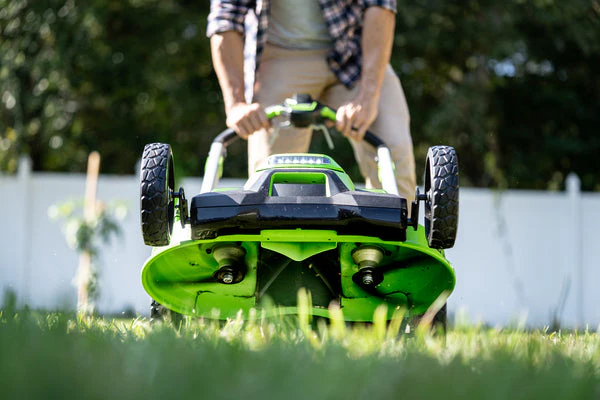
How to Sharpen Lawn Mower Blades
|
|
Is your lawn looking a bit rough around the edges after mowing? Chances are, it's not your technique to blame—it's a dull lawn mower blade! Sharpening your lawn mower blade is a lawn care game-changer, and here at Greenworks, we are here to guide you through it. Whether you're a first-timer or a seasoned lawn care enthusiast, these simple steps will transform your mowing experience and make your lawn the envy of the neighborhood.
Maintaining a sharp lawn mower blade is vital for a healthy, green lawn! Dull blades tear the grass and leave a ragged and uneven cut, putting unwanted stress on your lawn and leaving it vulnerable to disease discoloration.
Sharper blades mean quicker mowing and less strain on your mower. They also make your mowing more efficient by increasing cutting speeds and reducing general wear on your mower. A sharp blade slices through grass effortlessly, while a dull blade tears and damages the grass, leaving it prone to disease and discoloration.
Inspect your lawn after mowing—if the grass looks frayed or torn, it's a clear sign that your blade is dull. Next, inspect the blade for signs of wear, like nicks, dents or a rounded edge. Even small imperfections can hurt the blade's performance and lead to an uneven cut.
The rule of thumb is to sharpen your lawn mower blade after every 20 to 25 hours of use (though this can vary depending on the size of your lawn and grass conditions). For the average homeowner, sharpening your blade once or twice per mowing season should do.
Regular maintenance of your lawn mower blade involves more than just sharpening! It's important to clean the blade after each use to remove grass clippings and debris—this prevents the blade from rusting and keeps it in top condition.
Sharpening a lawn mower blade is a straightforward process, but it still needs proper attention to detail to ensure safety and effectiveness.
Before starting, round up the following tools and materials:
Pro tip: Before removing the blade, mark it to remember how to reinstall it. Reinstalling the blade upside down is a common mistake and can lead to frustration when the mower doesn't cut properly!
Whichever technique you use, sharpen from the top side of the cutting edge for the most durable result. Aim for "butter-knife" sharpness—overly sharp blades dull more quickly!
|
|
|
After sharpening, check the blade balance using a blade balancer (or hanging it on a nail). An unbalanced blade can cause excessive vibration, potentially damaging the mower! If the blade tilts, file off a bit more metal from the heavier side.
Secure the blade back onto the mower, ensuring it's tightly fastened. Properly tightening the bolt is crucial—an under-tightened bolt can disrupt mower performance.
Sharpening your lawn mower blade may seem like an unimportant task at first, but it makes a huge difference in the quality of your lawn's appearance and the performance of your mower.
Consider replacing your blade if it's excessively worn, bent, or damaged. It's also a good idea to have a spare blade to rotate between sharpenings and to avoid downtimes. Check out our selection of replacement mower blades.
Following these steps will ensure your mower blade is sharp, balanced and ready for mowing season. Remember, a well-maintained mower is the key to a beautiful, healthy lawn.

